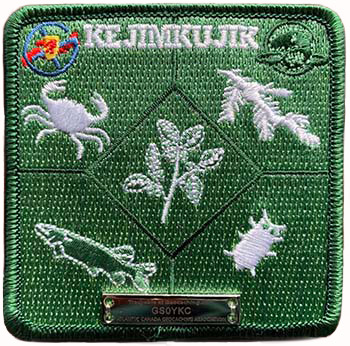
Geocaching
Kejimkujik National Park and National Historic Site
Come and geocache at Kejimkujik! Download the Geocaching® app to your smartphone, bring a GPS, or borrow a GPS from the Visitor Centre.
Fall, winter, and spring conditions
Note that trails are not maintained or patrolled between November 1 and Victoria Day weekend.
You may encounter washed out or flooded sections and/or downed trees.
Most facilities and services are closed at this time of year. More information
Emergencies: Call 911 and be prepared to have to wait for help to arrive.
What is Geocaching?
Geocaching is a modern treasure hunt popular with people of all ages. Participants use their GPS (Global Positioning System) or the Geocaching® app on their phone to locate a hidden “cache”. Cache containers come in various shapes and sizes, but typically contain a logbook so geocachers can record their find.
How to participate
Geocaching with the Geocaching® app (more details)
- Download the Geocaching® app to your smartphone. You will not need a geocaching passport as the cache coordinates and descriptions will be accessible within the Geocaching® app.
- Open the Geocaching® app, choose the map view, and zoom in on Kejimkujik.
- Click on the cache you’d like to find to see the description and helpful hints.
- Click on the Navigate button and follow the arrow to your destination. Please stay on the trails.
- Once you find the cache, sign the log book and replace the cache exactly where you found it.
- In the app, click on the “Log” button to record your find. You can also use this button to indicate if you were not able to find the cache, or if it needs maintenance.
- Simply click on the cache(s) you plan to find and tap the ellipsis at the top right of your screen (a circle with three small dots).
- Choose “Add to list” from the menu that pops up.
- The data for this cache will now be available to you off-line, allowing you to save data and access cache information should you lose cell phone reception while geocaching.
Visit the geocaching.com help centre for more information.
Geocaching with a GPS (more details)
- At the Visitor Centre, ask for a geocaching passport to get the cache coordinates and descriptions. You can also download your passport from the Association of Nova Scotia Geocaching and print it prior to your Kejimkujik visit.
- Choose the cache you’d like to find and enter the coordinates into your GPS.
- Navigate to the cache. Please stay on the trails.
- Once you’ve found the cache, use the punch to mark your passport.
- Sign the log book and replace the cache exactly where you found it.
Guidelines
Purchase your Kejimkujik day pass at the entrance kiosk.
Please stay on the trails. No caches will be off trail or buried.
It is not permitted to place trade items of any kind in the boxes.
Free wi-fi is available in the Visitor Centre parking lot, courtesy of the Friends of Keji Cooperating Association.
Ask for your free geocaching sticker at the Visitor Centre.
Geocaches at Kejimkujik
Parks Canada and the Association of Nova Scotia Geocaching are pleased to offer these geocaching series:
Be a Good Camper (launched in 2023)
The six caches in this series are hidden in the Jeremy’s Bay Campground.
Each cache explores a different aspect of camping etiquette, reminding us that individual and group efforts make for an all-around better camping experience for everyone.
Alien Invaders! (launched in 2021)

This series introduces several invasive species threatening the health of Kejimkujik’s forests and waters.
It includes five caches: four in Kejimkujik National Park and National Historic Site (inland) and one at Kejimkujik National Park Seaside.
Find all five caches to be eligible to purchase the trackable Alien Invaders patch from the Visitor Centre.
Explore Ukme’k! (launched in 2021)
This series of ten caches is hidden along Kejimkujik’s newest trail. Ukme’k, which means twisted in Mi’kmaq, is a 6.3 km trail that winds its way along the Mersey River.
Access Ukme’k from trailheads at the Visitor Centre, Flowing Waters, and Mersey River trail parking lots.
Keji Rocks! (launched in 2017)
Each of the three EarthCaches in this series showcases a different aspect of the area’s geologic history.
Rather than searching for a physical cache, you’ll be asked to answer a question about your surroundings to learn more about a geological feature or process.
Please note: At this time, your answers to the EarthCache questions can only be submitted online at geocaching.com or via the Geocaching® app. To view this series on the Geocaching® app, the premium version of the app is required.
Look Out! (launched in 2016)
With all three caches hidden at viewpoints in the front country, this series is a great introduction to geocaching.
Geocaching in National Parks
National parks are special places, protected for Canadians today, tomorrow, and into the future. Parks Canada has special guidelines for geocaching at their sites. For example, no caches will be buried or off trail, and it is not permitted to place trade items of any kind in the boxes.
Related links
- Activities and experiences at Kejimkujik National Park...
- Fall, winter, and spring at Kejimkujik
- Calendar of events
- The Coastie Initiative
- Hiking
- Canoeing, kayaking and stand-up paddleboarding (SUP)
- Swimming
- Fishing
- Parks Canada red chairs
- Explore the dark sky
- Tours and programs
- Picnicking
- Snowshoeing and cross-country skiing
- Date modified :